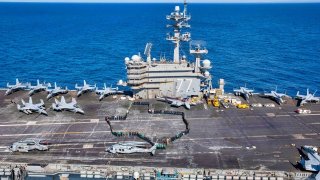Could Missile Defense Save the Aircraft Carrier?
U.S. aircraft carriers, formidable and nearly invulnerable since WWII, face new survivability concerns against modern adversaries like China. China's military expansion, including shipbuilding and missile stockpiles aimed at American vessels, highlights these threats. W
Summary: U.S. aircraft carriers, formidable and nearly invulnerable since WWII, face new survivability concerns against modern adversaries like China. China's military expansion, including shipbuilding and missile stockpiles aimed at American vessels, highlights these threats. While carriers benefit from advanced missile defense systems and a robust support network aimed at evading detection and countering attacks, reliance on such defenses is seen as a last resort. The challenge of tracking and targeting these moving behemoths across vast ocean spaces has been mitigated by technological advancements, yet the potential vulnerability of these naval giants in conflict scenarios remains a pressing issue.
Can Missile Defense Systems Shield U.S. Aircraft Carriers Against Modern Threats?
Can missile defense systems keep U.S. aircraft carriers safe in a conflict with an advanced adversary like China or Russia? Missile defense systems are a useful tool, and they increase a carrier’s survivability. But hopefully, preservation of the U.S. carrier fleet won’t come to rely on missile defense systems.
Survivability Concerns
U.S. aircraft carriers have operated with relative impunity since the end of World War II. Nuclear-powered behemoths surrounded with an entire carrier strike group, America’s 11 operational supercarriers are hard to kill.
But concerns have grown about the survivability of the aircraft carrier in a modern conflict environment. Enhancements to China’s military capabilities are especially worrying. China is in the midst of one of history’s most ambitious shipbuilding sprees, adding attack submarines, lithe surface vessels, and even aircraft carriers of their own.
More concerning still, China has stockpiled intermediate-range missiles, hypersonic missiles, and anti-ship missiles – undoubtedly with American vessels in mind.
Aircraft Carriers Are Hard to Kill
Hopefully, U.S. carriers would only rely on missile defense systems as a last resort.
“The first step in attacking a carrier is to find it,” the Lexington Institute wrote in 2001. “Most adversaries would have difficulty doing this as long as the carrier remains in the open sea, takes prudent evasive actions, and actively counters efforts at detection.”
China would need to monitor millions of square miles of ocean in any conflict with the U.S.. “For instance,” Forbes reported, “the South China Sea, comprising a fraction of the area that China would need to monitor in a conflict, consists of over 1.4 million square miles of ocean.”
If an adversary can find an aircraft carrier, the adversary must then continuously track it, “because a carrier is likely to be far from the location where it was first detected by the time weapons arrive there.”
Two decades ago, “few if any nations” had “an assured capacity to track carriers continuously,” the Lexington Institute wrote. “All of the relevant methods – radar, electronic eavesdropping, electro-optical and acoustic sensors – have major drawbacks such as high cost, vulnerability to pre-emption, and inability to precisely discriminate.”
China has worked to augment its carrier-tracking abilities in recent years, launching “half a dozen electronic intelligence satellites into low earth orbit,”Forbes reported. But “the U.S. could degrade such satellites using both kinetic and non-kinetic means.”
And should an adversary find and track a carrier, the ship may still depend on an integrated defensive network.
“The carrier commanding a carrier can expect to have diverse defensive assets stationed within reach of his or her constantly moving vessel – Aegis air-defense destroyers, Virginia-class attack subs, overhead assets, etc. – all networked together into a layered defensive system that detects any approaching threats,” Forbes reported. “Once identified, each threat is assigned the optimum sensors and weapons to assure early interception, even if they are on different warships scattered across the ocean.”
The defensive measures surrounding an aircraft carrier are layered and redundant. “The architecture of the defensive perimeter dictates that if an enemy penetrates one layer of protection, it will then face another, and another,” Forbes reported. “So even if the adversary can find a carrier in the vastness of the Western Pacific, the likelihood its weapons will reach the carrier and do serious damage is not great.”
Still, given the time, money, and human capital invested in each aircraft carrier, the mere hint of vulnerability is concerning.
About the Author: Harrison Kass
Harrison Kass is a defense and national security writer with over 1,000 total pieces on issues involving global affairs. An attorney, pilot, guitarist, and minor pro hockey player, Harrison joined the US Air Force as a Pilot Trainee but was medically discharged. Harrison holds a BA from Lake Forest College, a JD from the University of Oregon, and an MA from New York University. Harrison listens to Dokken.


